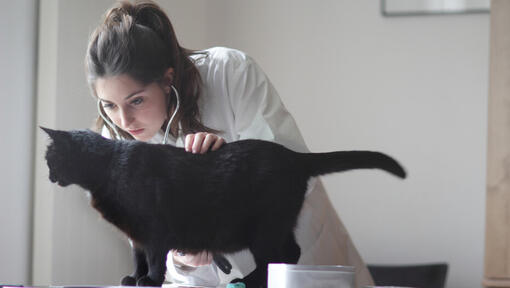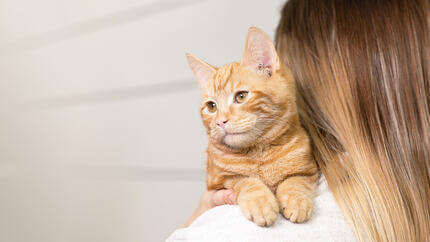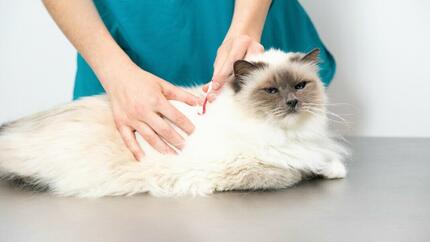

There’s nothing scarier than when our pets are unwell or hurt and we often naturally go into a panic as we don’t know what to do.
At Purina, we’ve created this guide to cat first aid to help you keep your pet calm and comfortable until you can reach your veterinarian.
Our cats are explorers at heart, whether it’s climbing the tree in the back garden or wandering off to investigate another cat ’s territory. Unfortunately, this love of adventure can sometimes land them in trouble and you may find yourself in need of some cat first aid skills.
At Purina, we’ve put together this guide of essential cat first aid tips so you can provide help straight away, giving you valuable time until you can get them to your vet.
How to tell if a cat is in pain
Cats are very secretive creatures and because of this we don’t always know if they’re in pain, so it can be hard to know when they need cat first aid. While it will largely depend on the specific illness or injury your pet has, a few of the most common cat illness or sickness symptoms they’ll display are as follows:
- Hiding, such as in a dark place or their cat igloo
- Rapid and shallow breathing
- Growling, hissing or crying
- Aggression both towards people and other pets in the home
- Sleeping more often
- Lack of appetite
- Obsessive licking of a particular area
- Lack of self-grooming
- Reluctance to move or engage in cat or kitten play
- Change in toileting
- Limping or difficulty getting around
Cat first aid
When your cat is in pain or suffering, knowing how to react can often make a huge difference. You’ll need to try and keep a level head and take deep breaths and remain calm, as your cat will likely be stressed and scared. The last thing you’ll want to do in an emergency situation is to make it worse by panicking, as cats are masters of sensing how we’re feeling.
The first thing you should do is contact your vet. By phoning them they’ll be able to prepare for your arrival, and if it’s an emergency they may try and talk you through some basic cat first aid via the phone too.
Never give your cat medicines intended for human use as these may be poisonous and cause an adverse reaction.
How to handle an injured cat
In the event you need to handle an injured cat to take them to the vets, you’ll need to know how to handle them safely. Unless advised otherwise by your vet depending on the circumstances here are our pointers: Approach them very slowly, then place one hand under their chin on the front of their chest, with the other between their back legs.
If they seem particularly aggressive, you may want to use a thick towel to protect yourself and wear protective gloves as well. Once you’ve got them, place them into a well-padded carrier to ensure their journey is as comfortable as possible. You may want to cover the carrier with a towel to help them feel less frightened.
Helping a cat that’s bleeding
If your cat seems to be bleeding, it’s important to apply cat first aid quickly in order to prevent shock or collapse. If you find yourself in a situation where you need to slow bleeding before help can be sought, follow these steps: firstly, apply pressure for at least 10 minutes using a wad of gauze, tissue or a clean cloth – this may be difficult and you might need to get someone else to help you if your cat is resisting. Do not tie a ligature around the area.
While you’re applying pressure, at no point should you lift the dressing to check if the bleeding has stopped as this could dislodge the clot. If the blood comes through the bandage, simply place a fresh one on top of the other one. Seek veterinary attention as soon as possible.
Cat first aid for broken bones
Take your cat to the vet as soon as possible. Support the affected area if you can with a towel underneath and gently lift them into a carrier. Never attempt to apply a splint yourself as this will do more harm than good and could cause the bone to break through the skin.
Dealing with burns and scalds
Soak a towel or flannel in cold water & apply directly to the affected area. Don’t apply any ointments or creams as this may create irritation, but you can use saline-soaked gauze to protect the area. Once you’ve done this, take them to the vet straight away.
What to do if your cat’s been poisoned
If you know your cat’s been poisoned through eating something, it’s more important to get to a vet than spend time on cat first aid. You’ll need to locate the poison, phone the vet and get them there as soon as possible. It’s important that you bring the label or any information about what your cat has eaten, or if it’s a plant, get the name of it and take a sample or photo with you.
Helping a fitting cat
A common mistake that owners make when they see their cat having a fit is to try and hold them. Instead, you should darken the room, turn off anything that makes noise and make sure you remove anything that your cat could hurt themselves with. Once you’ve done this, phone your vet and they’ll recommend the next course of action.
Insect bites or stings
When using cat first aid to treat insect bites or stings, the first thing you should do is check if the stinger is still in your pet. If it is, try to carefully remove it with tweezers, making sure you don’t squeeze as you may release additional venom.
If you’re worried, leave it in and take them to the vet so they can remove it for you. If the stinger is out, bathe the area with an alkali such as baking soda dissolved in cold water for bee or insect stings, or use lemon juice or vinegar for wasp stings instead. If you’re not sure what the insect was, use clean water instead.
If the insect bite or sting is in your pets’ mouth, take them to the vet right away as it could swell and cause breathing difficulties.
What to do if your cat is choking
If your cat’s choking, wrap them in a towel and open their mouth. It’s important that you don’t tilt their head back as it may cause the object to fall down their throat, so you may need two people for this - one to hold and support the cat, and another to look inside the cat’s mouth for objects. If the object is visible and doesn’t appear to be attached to anything, take it out with blunt tweezers. If the object looks like it could be attached to something, don’t pull at it. Contact your vet and get them to the surgery right away.
Cat first aid should only ever be used to help your cat until you can get to a veterinarian – it should never be used instead of professional care but in cases where immediate action is required. Always ensure that you have your vet’s number saved in your phone as you never know when you might need it.













